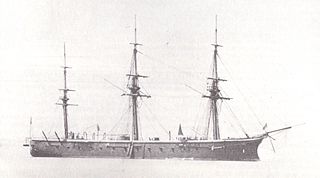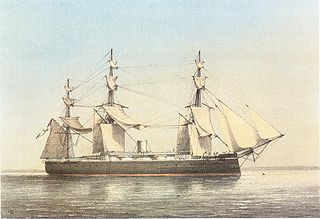
An ironclad is a steam-propelled warship protected by iron or steel armor plates, constructed from 1859 to the early 1890s. The ironclad was developed as a result of the vulnerability of wooden warships to explosive or incendiary shells. The first ironclad battleship, Gloire, was launched by the French Navy in November 1859 – narrowly pre-empting the British Royal Navy, though Britain built the first completely iron-hulled warships.

The seventh HMS Enterprise of the Royal Navy was an armoured sloop launched in 1864 at Deptford Dockyard. Originally laid down as a wooden screw sloop of the Camelion class, she was redesigned by Edward Reed and completed as a central battery ironclad. The ship spent the bulk of her career assigned to the Mediterranean Fleet before returning to England in 1871 where she was paid off. Enterprise was sold for scrap in 1885.

HMS Warrior is a 40-gun steam-powered armoured frigate built for the Royal Navy in 1859–1861. She was the name ship of the Warrior-class ironclads. Warrior and her sister ship HMS Black Prince were the first armour-plated, iron-hulled warships, and were built in response to France's launching in 1859 of the first ocean-going ironclad warship, the wooden-hulled Gloire. Warrior conducted a publicity tour of Great Britain in 1863 and spent her active career with the Channel Squadron. Obsolescent following the 1873 commissioning of the mastless and more capable HMS Devastation, she was placed in reserve in 1875, and was "paid off" – decommissioned – in 1883.
HMS Valiant was the second ship of the Hector-class armoured frigates ordered by the Royal Navy in 1861. Her builders went bankrupt shortly after she was laid down, which significantly delayed her completion. After being launched in 1863, she waited a further five years to receive her guns due to supply issues. Upon being commissioned in 1868 the ship was assigned as the First Reserve guard ship for Southern Ireland, where she remained until she was decommissioned in 1885. Valiant was hulked in 1897 as part of the stoker training school HMS Indus before becoming a storeship for kite balloons during the First World War. The ship was converted to a floating oil tank in 1926 and served in that role until sold for scrap in 1956.

HMS Defence was the lead ship of the Defence-class armoured frigates ordered by the Royal Navy in 1859. Upon completion in 1862 she was assigned to the Channel Fleet. The ship was paid off in 1866 to be refitted and rearmed and was briefly reassigned to the Channel Fleet when she recommissioned in 1868. Defence had short tours on the North Atlantic and Mediterranean Stations, relieving other ironclads, from 1869 to 1872 before she was refitted again from 1872 to 1874. She became guard ship on the River Shannon when she recommissioned. The ship was transferred to the Channel Fleet again in 1876 and then became guard ship on the River Mersey until 1885. Defence was placed in reserve until 1890, when she was assigned to the mechanical training school in Devonport in 1890. She was renamed Indus when the school adopted that name and served there until sold for scrap in 1935.

The Defence-class ironclads were a class of two warships built for the Royal Navy between 1859 and 1862. The ships were designed as armoured frigates in response to an invasion scare sparked by the launch of the French ironclad Gloire and her three sisters in 1858. They were initially armed with a mix of rifled breech-loading and muzzle-loading smoothbore guns, but the Armstrong breech-loading guns proved unreliable and were withdrawn from service after a few years.
The Hector-class ironclads were a pair of armoured frigates built for the Royal Navy (RN) in the 1860s. Hector was completed in 1864 and assigned to the Channel Fleet until she began a refit in 1867. Valiant's builder went bankrupt, delaying her launching by a year. The ship then had to wait almost another five years to receive her guns and be commissioned. Both ships were assigned to the Reserve Fleet from 1868 until they were paid off in 1885–1886. They were mobilized during the Russo-Turkish War of 1877–1878, but saw no action. They were hulked in the late 1890s and assigned to shore establishments. Hector was scrapped in 1905, but Valiant was converted into a floating oil tank in 1926; she was sold for scrap thirty years later.

HMS Achilles was an armoured frigate built for the Royal Navy in the 1860s. Upon her completion in 1864 she was assigned to the Channel Fleet. The ship was paid off in 1868 to refit and be re-armed. When she recommissioned in 1869, she was assigned as the guard ship of the Fleet Reserve in the Portland District until 1874. Achilles was refitted and re-armed again in 1874 and became the guard ship of the Liverpool District in 1875. Two years later, she was rejoined the Channel Fleet before going to the Mediterranean in 1878. The ship returned to the Channel Fleet in 1880 and served until she was paid off in 1885.

The Prince Consort class of ironclad battleship were four Royal Navy wooden-hulled broadside ironclads: HMS Royal Oak, HMS Prince Consort, HMS Ocean, and HMS Caledonia. They were originally laid down as Bulwark-class battleship, but were converted to ironclads. Royal Oak was Britain's fifth ironclad battleship completed.

HMS Lord Warden was the second and last ship of the wooden-hulled Lord Clyde class of armoured frigates built for the Royal Navy (RN) during the 1860s. She and her sister ship, Lord Clyde, were the heaviest wooden ships ever built and were also the fastest steaming wooden ships. They were also the slowest-sailing ironclads in the RN.

HMS Bellerophon was a central battery ironclad built for the Royal Navy in the mid-1860s.

HMS Monarch was the first seagoing British warship to carry her guns in turrets, and the first British warship to carry guns of 12-inch (300 mm) calibre.
The box battery is a disposition of the main armament in a battleship, commonly used in ships built in the latter half of the 19th century. A box battery consists of a thick armour surrounding a central battery to protect the guns. It was an interim disposition between full-length broadside guns and turret-mounted artillery.

The Magenta class consisted of two broadside ironclads built for the French Navy in the early 1860s. They were the only ironclad two-deckers ever built, and the first ironclads to feature a naval ram.

The Spanish ironclad Vitoria was an iron-hulled armored frigate purchased from England during the 1860s. The ship participated on both sides during the Cantonal rebellion of 1873–1874, first on the rebel side and then after her crew surrendered to neutral warships, on the government side. She played a major role in the Battle off Cartagena for the government. Vitoria bombarded rebel towns from 1874 to 1876 during the Third Carlist War. The ship was reconstructed in the late 1890s and reclassified as a coast-defense ship, although she served as a training ship until she was scrapped in 1912.

The Spanish ironclad Sagunto was a wooden-hulled armored frigate built for the Royal Spanish Navy in the 1860s and 1870s. She was originally built as a large ship of the line, but was converted into a central-battery ironclad while still under construction. She was stricken from the naval register in 1891.

The Russian ironclad Ne Tron Menia was the second of the three Pervenets-class broadside ironclads built for the Imperial Russian Navy during the mid-1860s. She joined the Baltic Fleet upon completion and never left Russian waters. Beginning in 1870 the ship was assigned to the Gunnery Training Detachment and was frequently rearmed. Ne Tron Menia was placed in reserve and hulked a decade later. In 1905 the ship was disarmed and she was sold in 1908. After the end of the Russian Civil War, she was acquired by the Soviets before being sold to a factory in 1925. The ship was sunk in the Siege of Leningrad during World War II and was scrapped after she was salvaged in 1950.

The Provence-class ironclads consisted of 10 ironclad frigates built for the French Navy during the 1860s. Only one of the sister ships was built with an wrought iron hull; the others were built in wood. By 1865 they were armed with eleven 194-millimeter (7.6 in) guns and played a minor role in the 1870–1871 Franco-Prussian War. The ships began to be disposed of in the early 1880s, although several lingered on in subsidiary roles for another decade before they followed their sisters to the scrap yard.

The French ironclad Héroïne was one of 10 Provence-class armored frigates built for the French Navy during the 1860s. She was the only ship of the class to be built with an iron hull. Completed in 1865, the ship was initially assigned to the Northern Squadron, sometimes serving as a flagship. The ironclad played a minor role in the Franco-Prussian War of 1870–1871, blockading the North Sea coast of Prussia and a Prussian commerce raider in a neutral Spanish port. Héroïne was decommissioned after the war, but was reactivated in 1876 and was assigned to the Mediterranean Squadron.
















